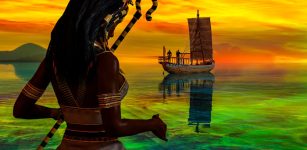Our Lives Have Always Been Manipulated By Money – Part 1
A. Sutherland - AncientPages.com - For 4500 years, human life was controlled and even manipulated by money. Ever since ancient times, money has played a central role in people's lives, regardless of whether payment has been rare shells, worthless iron coins, small springs, or stamped precious metal pieces.
Chinese bronze coins. Image credit: Plismo - CC BY-SA 3.0
In Greece, for example, prehistoric falsifiers covered cheap copper with a thin layer of gold and tin they used to cover with the thin layer of silver.
We go back 4500 years and find that silver rods were the world's first money. They were introduced in Mesopotamia to smooth the progress of trade. The origin of money is hidden in the far distant past, but for the first time, money was mentioned in writings in Mesopotamia (today: Iraq).
According to ancient cuneiform tablets, pure silver was the first standardized payment. They were shaped like rods cut off and weighed when a business was ready to be implemented.
The introduction of silver most probably took place for purely practical reasons. Trade was prevalent in the highly developed Mesopotamia, and natural objects were often heavy and unwieldy, so it was much easier to take small silver rods than oxen or cereal. According to historians, cuneiform tablets were invented for easier bookkeeping of the growing number of trade transactions.
For thousands of years, China has been using gold, silver, and even copper money, which were in circulation besides the well-known cowrie shells.
Even in those distant times, a very "elementary process of minting was in vogue; and the coins were known as the round money, bell-shaped money, and the knife-shaped money." (S.R. Wagel, "Chinese Currency And Banking")
During the early periods of China's history, the shells constituted the only medium of exchange.
About 3500 years ago, the Chinese began to use small shells as money. Shells were perfect money for the Chinese people. They were lightweight, durable, small, easy to carry, and impossible to falsify.
The extent of shell currency is currently unclear, but it was probably prevalent. As the Chinese writing system developed, it used the shell sign as the symbol for 'money.' Similarly, shells were included in characters, including such terms like "buy," "sell," and "barter."
The shells, very coveted by people living along the Indian Ocean until the 1900s, were used to pay for groceries, including food. On the other hand, the Chinese were not the only ones who paid with shells', which also suffered inflation like our modern currency.
For example, in remote regions of Uganda, a wife cost only two shells (!) in the 1700s. As a result of inflation, more than 1000 shells had to be paid to buy a wife in 1860.
People improved the roads to the sea, and many more shells came into circulation, and their value decreased. Coins of metal were known in ancient Egypt, though wealthy merchants dealing with foreign partners almost exclusively limited their use.
The most common payment among ordinary people was cereal. A monthly salary of around 200 kg was used in barter trade to obtain other goods.
Right: Papua New Guinea shell money. Image credit: Department of Foreign Affairs and Trade - SOLS0344- CC BY 2.0
Egyptians could put grain, receive or borrow some if necessary, while banks' goal was to stimulate trade, built up power, and a network of public cereal. Bank customers received a receipt for their deposits and loans and could take out or pay in other cereal banks. The receipts were also used as payment in trade.
To prevent fraud in the local bank branches, the central bank in Alexandria had copies of all service accounts.
Once upon a time, there was an Iron Age kingdom in western Asia Minor known as the Kingdom Of Lydia. Lydia was considered one of the wealthiest kingdoms of antiquity when it replaced the metal lumps with beautifully minted coins. The Lydian money was called the "Adam of coins" because it inspired later periods of coins in Europe and the Middle East. The Kingdom of Lydia was not more extensive than a city-state, but that seemingly insignificant kingdom left behind a legacy that would change history: coins.
There were already various forms of money in Egypt, China, and other great ancient kingdoms. Still, in Lydia, it was recognized the importance of a small and manageable payment for the first time.
To eliminate the great inconveniences of non-standardized money, banks and goldsmiths began to convert metal into standard coins, giving them specified shape, weight, and fineness. Circa 640 BC, the Lydian kings were the first to strike average weight and common size coins. They also marked them with their sigils to ensure the metal's authenticity. Additionally, they counted the coins!
Coins revolutionized trade because Lydian merchants no longer needed to devote their precious time weighing silver and gold pieces or exploring the metal's purity.
"Virtually all coinage in use today is the progeny" of what the Lydians initiated. (Porteous, "The Nature of Coinage")
Written by – A. Sutherland AncientPages.com Staff Writer
Copyright © AncientPages.com All rights reserved. This material may not be published, broadcast, rewritten or redistributed in whole or part without the express written permission of AncientPages.com
Expand for referencesReferences:
G. Davies, "History of Money"
S.R. Wagel, "Chinese Currency And Banking"
More From Ancient Pages
-
 Genghis Khan Has 16 Million Relatives – You Could Be One Of Them
Ancient History Facts | Feb 3, 2018
Genghis Khan Has 16 Million Relatives – You Could Be One Of Them
Ancient History Facts | Feb 3, 2018 -
 Mysterious ‘Las Labradas’ Petroglyphs With Roots In The Pre-Columbian Times Of Mexico
Featured Stories | Oct 9, 2020
Mysterious ‘Las Labradas’ Petroglyphs With Roots In The Pre-Columbian Times Of Mexico
Featured Stories | Oct 9, 2020 -
 The Bushido Code: Centuries-Old Unwritten Code For Ideal Samurai Warrior
Featured Stories | Dec 26, 2016
The Bushido Code: Centuries-Old Unwritten Code For Ideal Samurai Warrior
Featured Stories | Dec 26, 2016 -
 Earliest Period Of Warfare In Europe Occurred Over 1,000 Years Earlier Than We Thought
Archaeology | Nov 3, 2023
Earliest Period Of Warfare In Europe Occurred Over 1,000 Years Earlier Than We Thought
Archaeology | Nov 3, 2023 -
 Unique And Priceless Large Roman Sculptures Found At Carlisle Cricket Club
Archaeology | May 25, 2023
Unique And Priceless Large Roman Sculptures Found At Carlisle Cricket Club
Archaeology | May 25, 2023 -
 Adaptable And Flexible Neanderthals May Have Inhabited Danish Island 120,000 Years Ago
Archaeology | Oct 25, 2020
Adaptable And Flexible Neanderthals May Have Inhabited Danish Island 120,000 Years Ago
Archaeology | Oct 25, 2020 -
 Mysterious Scottish Stone Circles On Orkney Were Used To Something Very Different Than Previously Thought
Archaeology | Sep 24, 2017
Mysterious Scottish Stone Circles On Orkney Were Used To Something Very Different Than Previously Thought
Archaeology | Sep 24, 2017 -
 Ancient ‘Yahweh And His Asherah’ Inscriptions At Kuntillet ‘Ajrud Remain An Unsolved Biblical Mystery
Biblical Mysteries | Feb 12, 2021
Ancient ‘Yahweh And His Asherah’ Inscriptions At Kuntillet ‘Ajrud Remain An Unsolved Biblical Mystery
Biblical Mysteries | Feb 12, 2021 -
 Did The Dogon Tribe Have Knowledge Of Theoretical Physics 5,000 Years Ago?
Ancient Mysteries | Aug 2, 2017
Did The Dogon Tribe Have Knowledge Of Theoretical Physics 5,000 Years Ago?
Ancient Mysteries | Aug 2, 2017 -
 Mounds In Louisiana, North America Offer Insight Into Middle Archaic Lifestyles
Archaeology | Dec 2, 2022
Mounds In Louisiana, North America Offer Insight Into Middle Archaic Lifestyles
Archaeology | Dec 2, 2022 -
 Thales Of Miletus: One Of The Famous “Seven Sages Of Greece” Who Predicted A Solar Eclipse
Featured Stories | Aug 12, 2016
Thales Of Miletus: One Of The Famous “Seven Sages Of Greece” Who Predicted A Solar Eclipse
Featured Stories | Aug 12, 2016 -
 Was Princess Tadukhipa Of The Mitanni Kingdom Queen Nefertiti?
Civilizations | Mar 15, 2016
Was Princess Tadukhipa Of The Mitanni Kingdom Queen Nefertiti?
Civilizations | Mar 15, 2016 -
 Niches With Six Figures Cut In Rock Discovered At Gebel Al-Silsila, Aswan
Archaeology | Dec 27, 2015
Niches With Six Figures Cut In Rock Discovered At Gebel Al-Silsila, Aswan
Archaeology | Dec 27, 2015 -
 Giant Pre-Hispanic Jar Used To Make Mexican Traditional Corn Beer
Archaeology | May 6, 2020
Giant Pre-Hispanic Jar Used To Make Mexican Traditional Corn Beer
Archaeology | May 6, 2020 -
 Mysterious Teotihuacan ‘Host’ Figurines From Metepec, Mexico
Artifacts | Jan 6, 2016
Mysterious Teotihuacan ‘Host’ Figurines From Metepec, Mexico
Artifacts | Jan 6, 2016 -
 Persephone: Greek Goddess Of The Coming Spring And Lady Of The Land Of The Dead
Featured Stories | Jun 26, 2021
Persephone: Greek Goddess Of The Coming Spring And Lady Of The Land Of The Dead
Featured Stories | Jun 26, 2021 -
 On This Day In History: Terrible Day In Moscow Engulfed By Fire – On June 21, 1547
News | Jun 20, 2016
On This Day In History: Terrible Day In Moscow Engulfed By Fire – On June 21, 1547
News | Jun 20, 2016 -
 Pandavleni Caves: Skillfully Carved Rocky Realms Decorated With Sculptures And Inscriptions In Brahmi Script
Featured Stories | Aug 1, 2016
Pandavleni Caves: Skillfully Carved Rocky Realms Decorated With Sculptures And Inscriptions In Brahmi Script
Featured Stories | Aug 1, 2016 -
 Roman Herculaneum: Men And Women Had Different Diets – New Study
Archaeology | Aug 26, 2021
Roman Herculaneum: Men And Women Had Different Diets – New Study
Archaeology | Aug 26, 2021 -
 King Tut’s Cosmic Scarab Brooch And Dagger Linked To Meteorite’s Crash 28 Million Years Ago
Artifacts | Jun 17, 2021
King Tut’s Cosmic Scarab Brooch And Dagger Linked To Meteorite’s Crash 28 Million Years Ago
Artifacts | Jun 17, 2021



